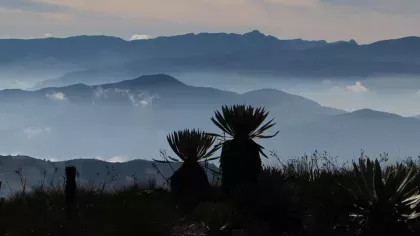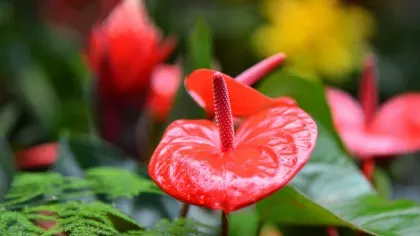Boyacá’s Páramo Plants for Life
Researching the impact of climate change on important plants for the ecosystem services of the páramos of Boyacá, Colombia.

Background
Colombia is known to be one of the most biodiverse countries in the world. Nevertheless, the current knowledge on inventory and monitoring of biodiversity and ecosystems does not fully reflect this richness, being incomplete in certain regions. Counteracting this situation, the nation-wide ‘Colombia Bio’ programme has recently been established by the Colombian government with the main aim of making sustainable economic use of Colombia’s biodiversity resources. This programme offers a unique opportunity for Kew and partner organisations in Colombia to undertake primary research on biodiversity and ecosystem services in parts of the country as yet completely unexplored. The ambition of this exploratory research is to enable long-term plans for the conservation and sustainable use of Colombia’s natural capital to be established.
Kew Science will be involved in a significant number of research projects over the next 4-5 years (from 2017) under the umbrella of the Colombia Bio programme.
This particular project is designed to assess the impact of climate change on important plants for the ecosystem services of the páramos of Boyacá, one of 32 regions in Colombia.
High Altitude Sky Islands
The páramos in Colombia, the high-altitude sky islands dominated by grasslands, rosettes and bushes above the timber-line in the tropical Andes, provide priceless ecosystem services to local communities. For example, páramos play a fundamental role in providing fresh water - they act as living sponges due to the plants’ adaptations to the unique climate conditions. In fact, it has been estimated that a páramo releases 2-5 litres of water per m2 per day, and more than 80% of the fresh water of Bogotá, Quito, Medellín, Cuenca, Piura, Cajamarca and other cities comes from this ecosystem.
In addition, páramos are recognized as the world’s most diverse high-elevation ecosystem, with an exceptionally high level of plant species endemic to their area. Hundreds of the more than 4,700 páramo plant species are frequently used by local people as a source of medicine, food, spices, condiments, construction materials, firewood, etc.
Unfortunately, the area covered by páramos is shrinking at an alarming pace, mostly due to climate change via increased temperatures and changes in rainfall patterns. Future projections suggest a reduction of its extent by around 50% by mid-century. At the species level, it is projected that between 10 and 47% of Andean endemic species will become extinct by 2100.
The Importance of the Páramos in Boyacá
The research project that Kew launched in June 2017 is designed to assess the impact of climate change on plants of the páramos of the Colombian region of Boyacá that are important for ecosystem services, where páramos cover 25% of its territory (5,384 km2). There are in fact six páramo complexes surrounded by urban centres where most people’s livelihoods depend on this ecosystem. People living in the páramo are so connected to these highlands that even their culture is called “cultura paramuna” (culture from the páramos). Therefore, a degradation of these lands would have enormous consequences, not just for the livelihoods of communities, but also for their culture and traditions. The páramos of Boyacá are also extremely biodiverse: they hold more than 2,354 known plant and lichen species. This is nearly half of the 4,646 species of plants and lichens reported for the entire region.
The consequences of climate change on the páramos are still unclear so over the next 9 months we will be working out the likely responses (e.g. change in functional traits, contraction or expansion of range, or even extinction) of key plant species, to assess the threats for the páramo ecosystem and its services. The project team will join the field expeditions of the “Expeditions Bio Boyacá” to the prioritised páramos El Valle, El Consuelo, Pisba, Ocetá, Bijagual-Mamapacha and Rabanal to collect a range of data on 100 key plant species (based on their known contribution to the different categories of ecosystem services). We will then use different scenarios to model the impact of climate change on their distributions and functions in the ecosystem.
Results from this project will inform decision makers as well as social and conservation organizations about the likely impacts of climate change on the ecosystem services provided by the páramos of Boyacá, and the potential consequences for human livelihoods.
Objectives
The specific objectives of this project are to:
- Select key species and carry out fieldwork to collect data on their distributions, functional traits, and associated ecosystem services.
- Model the impact of climate change on future distributions of the key species, to assess their likely responses.
- Analyse the expected impacts of climate change on the identified functional traits and ecosystem services associated with them, to estimate the potential impacts on livelihoods.
- Collection of data on 100 key plant species – their distributions, functional traits, and the ecosystem services associated with each.
- Climate change impact models covering each of these aspects – these will generate novel knowledge about the potential sensitivity of Boyacá’s páramo key plant species, and hence the risk of disruption to ecosystem services.
- This information will provide an outline for the next IPCC, detailing what ecosystem services are most affected by climate change, at what magnitude and in which areas of the páramos of Boyacá.
- The project’s methods and data have the potential of being replicated in other areas of interest.
- Knowledge will be disseminated through a broad range of media: peer-reviewed journals with high impact factor (e.g. Nature Climate Change (IF 17.184), Global Change Biology (IF 8.444), Diversity and Distributions (IF 4.830)), opinion magazines and newspapers.
- Developed models will be discussed and shared with experts from the Humboldt Institute, and will be incorporated into the BioModelos portal.
Funders
- Royal Botanic Gardens, Kew
- UK Department for Business, Energy & Industrial Strategy (BEIS)
- UK Official Development Assistance (ODA)
- Newton Fund
- The British Council
- Colombian National Royalties’ System
- Administrative Department of Science, Technology and Innovation of Colombia (Colciencias)
Partners and collaborators
Contact
#KewColombiaBioBoyaca
#KewColombiaBio
Related Strategic Outputs
Useful Plants and Fungi Portal

